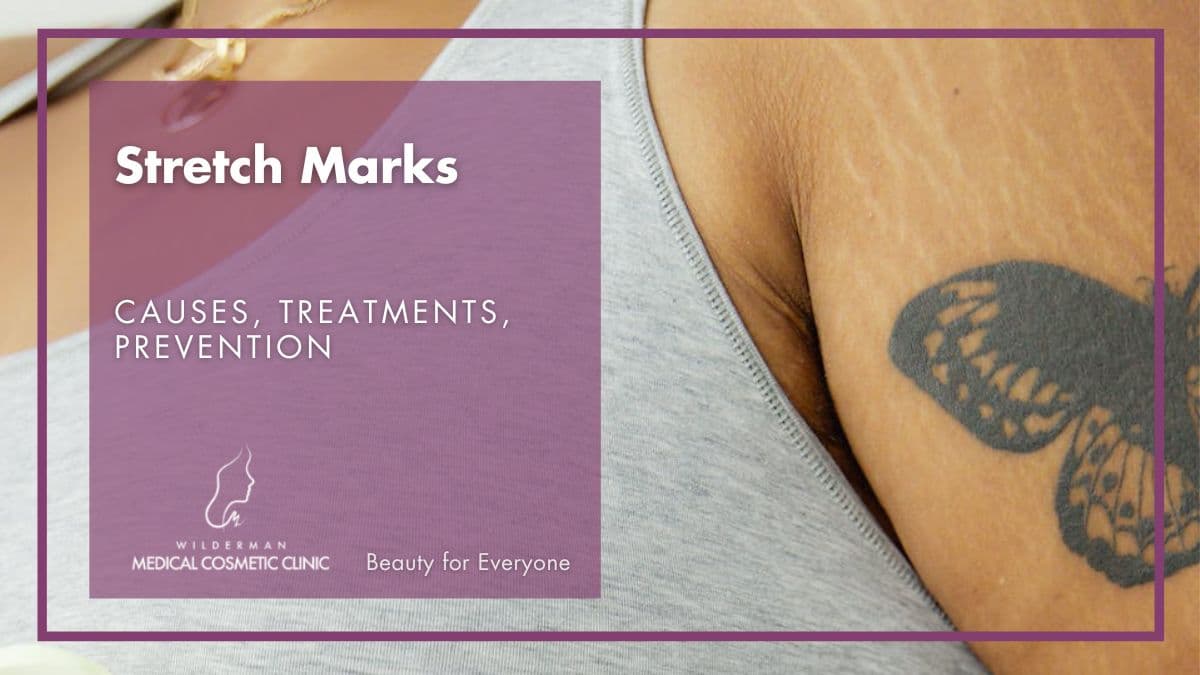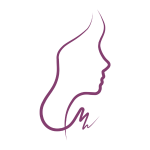Stretch Marks
Causes, Treatments, Prevention
Stretch marks, also known as striae, are a common skin condition that affects both men and women.
They often appear as visible lines on the skin, typically on the abdomen, thighs, buttocks, breasts, or upper arms.

Get immediate answers about possible treatment options tailored for you, expected results, and much more.
- Expert Diagnosis
- Customized Treatment Plans
- No Obligation
- Comfort and Privacy
- Immediate Answers
While they pose no health risks, stretch marks can cause self-consciousness and may impact an individual’s self-esteem.
In this article, we will explore the causes of stretch marks, their prevalence, treatment options, and preventive measures to help you better understand and manage this common skin concern.
What Causes Stretch Marks?
Stretch marks occur when the skin is stretched beyond its elastic limit, causing the collagen and elastin fibers within the dermis to break. Some common causes include:
- Rapid growth: Adolescents experiencing growth spurts during puberty may develop stretch marks. The rapid stretching of the skin outpaces the production of collagen and elastin fibers, leading to the formation of stretch marks.
- Pregnancy: Pregnant women commonly develop stretch marks as their bodies undergo significant changes to accommodate the growing fetus.
- Weight fluctuations: Rapid weight gain or loss can cause the skin to stretch or contract abruptly, resulting in the formation of stretch marks. This can happen due to obesity, sudden weight gain during muscle building or bodybuilding, or significant weight loss through diet or surgery.
- Hormonal changes: Hormonal imbalances, such as those experienced during puberty, pregnancy, or hormone therapies, can influence the development of stretch marks. Hormones like corticosteroids can decrease the skin’s elasticity, making it more prone to stretch marks.
- Genetic factors: Some individuals may have a genetic predisposition to developing stretch marks. If your parents or close family members have had stretch marks, you may be more likely to develop them as well.
- Medical conditions: Certain medical conditions, such as Cushing’s syndrome and Marfan syndrome, can weaken the skin’s elasticity, making it more susceptible to stretch marks.
It is important to note that anyone can develop stretch marks, regardless of age, gender, or body type. However, the likelihood and severity of stretch marks can vary from person to person based on the factors mentioned above.
What are the Treatment Options for Stretch Marks?
While stretch marks cannot be completely eradicated, several treatment options are available to help reduce their appearance. The effectiveness of these treatments can vary depending on factors such as the age of the stretch marks, their severity, and individual skin characteristics.
Here are some common treatment options for stretch marks:
- Topical creams and lotions: Over-the-counter creams and lotions containing ingredients such as retinol, hyaluronic acid, vitamin C, or glycolic acid may help improve the appearance of stretch marks. These products can promote collagen production, increase skin elasticity, and fade the color of stretch marks over time.
- Prescription medications: In some cases, aesthetic physicians may prescribe stronger creams or ointments that contain retinoids or other ingredients to enhance their effectiveness. These prescription medications can help reduce the appearance of stretch marks, particularly when used in combination with other treatments.
- Laser therapy: Various laser treatments can be employed to stimulate collagen production and fade the appearance of stretch marks. Fractional laser resurfacing is a popular technique that targets the affected areas with microscopic laser beams, stimulating the growth of new skin cells and improving the skin’s texture and tone.
- Microdermabrasion: This non-invasive procedure involves exfoliating the outer layer of the skin using tiny crystals or a special device. Microdermabrasion can help improve the texture and color of stretch marks by removing dead skin cells and promoting the growth of new, healthier skin.
- Chemical peels: Chemical peels involve applying a chemical solution to the skin, which exfoliates the outer layer and promotes skin regeneration. Superficial or medium-depth chemical peels can be used to minimize the appearance of stretch marks by encouraging new collagen growth.
- Microneedling: Microneedling, also known as collagen induction therapy, involves using a device with fine needles to create tiny punctures in the skin. This stimulates collagen production and promotes skin rejuvenation, helping to reduce the appearance of stretch marks.
- Dermabrasion: Dermabrasion is a procedure that involves the controlled removal of the outermost layers of the skin using a rotating brush or diamond wheel. This mechanical exfoliation technique helps to improve the texture and appearance of stretch marks by stimulating collagen production and encouraging the growth of new, healthier skin cells.
- Ultrasound therapy: Ultrasound therapy, also known as ultrasound skin tightening, utilizes high-frequency sound waves to stimulate collagen production and improve the elasticity of the skin. This non-invasive treatment can be effective in reducing the appearance of stretch marks by promoting tissue regeneration and tightening the skin in the targeted area.
- Cosmetic procedures: In more severe cases, cosmetic procedures like abdominoplasty (tummy tuck) or autologous fat transfer may be considered.
It’s important to note that the effectiveness of these treatments can vary, and not all options may be suitable for everyone. Consulting with an aesthetic physician or a qualified healthcare professional is crucial to determining the most appropriate treatment plan based on individual circumstances.
How to Prevent Stretch Marks?
Preventing stretch marks entirely may not be possible, as they can be influenced by various factors such as genetics and hormonal changes. However, taking certain preventive measures can help minimize their occurrence.
Here are some tips to consider:
- Maintain a healthy weight: Weight management can help prevent the rapid stretching of the skin that contributes to stretch marks. Avoid rapid weight gain or loss, as these can strain the skin’s elasticity.
- Stay hydrated: Keeping your skin well-hydrated and moisturized can improve its elasticity and flexibility, reducing the risk of stretch marks. Drink an adequate amount of water daily and use moisturizers or oils to keep your skin hydrated, especially during pregnancy or periods of rapid growth.
- Follow a balanced diet: Consuming a nutritious diet that includes vitamins, minerals, and proteins can support skin health. Foods rich in vitamins A, C, and E, as well as zinc and silicon, can promote skin elasticity and resilience.
- Gradually increase exercise intensity: If you’re planning to engage in intense physical activities or weightlifting, gradually increase the intensity and duration of your workouts. This allows your skin and muscles to adapt gradually, reducing the risk of rapid stretching and subsequent stretch marks.
- Use caution during pregnancy: Pregnancy is a common time for stretch marks to develop. While prevention is challenging, applying creams or oils specifically formulated to prevent stretch marks during pregnancy can help keep the skin hydrated and supple.
- Protect your skin from excessive sun exposure: Prolonged exposure to harmful UV rays can weaken the skin’s elasticity and make it more prone to stretch marks. Always apply sunscreen with a high SPF when going out in the sun and seek shade during peak hours.
- Massage your skin: Regularly massaging the areas prone to stretch marks can help improve blood circulation and enhance the skin’s elasticity. Use gentle circular motions and consider using moisturizers or oils during the massage.
Conclusion
While it may not be possible to prevent stretch marks entirely, adopting preventive measures such as maintaining a healthy weight, staying hydrated, following a balanced diet, and protecting the skin from excessive sun exposure can help minimize their occurrence.
Treatment options like topical creams, laser therapy, microdermabrasion, and cosmetic procedures can help reduce the visibility of existing stretch marks. It is essential to consult with a qualified aesthetic physician or healthcare professional to determine if these treatments are suitable for your specific situation.
They can assess your skin condition, discuss potential risks and benefits, and recommend the most appropriate treatment plan for your needs.
However, it’s important to embrace and care for your body, recognizing that stretch marks are a natural part of life. Developing self-acceptance and body positivity are essential for overall well-being.
Reference
Cleveland Clinic. Stretch Marks. Retrieved from https://my.clevelandclinic.org/health/articles/10785-stretchmarks#:~:text=Stretch%20marks%20are%20a%20form,dermabrasion%2C%20microneedling%20and%20retinol%20creams. Accessed on June4, 2023.
Mayo Clinic. Stretch marks: Diagnosis & treatment. Retrieved from https://www.mayoclinic.org/diseases-conditions/stretch-marks/diagnosis-treatment/drc-20351144. Accessed on June4, 2023.
American Academy of Dermatology Association. Stretch Marks: Why They Appear and How to Get Rid of Them. Retrieved from https://www.aad.org/public/cosmetic/scars-stretch-marks/stretch-marks-why-appear. Accessed on June4, 2023.
Healthline. Stretch Marks: Causes, Treatments, and Prevention. Retrieved from https://www.healthline.com/health/stretch-marks#causes. Accessed on June4, 2023.
NHS. Stretch marks. Retrieved from https://www.nhs.uk/conditions/stretch-marks/. Accessed on June4, 2023.
Other skin conditions that may be of interest
Skin Laxity: A common skin concern – Skin laxity is a common concern that many individuals experience as they age. It is characterized by a loss of firmness, elasticity, and resilience in the skin, leading to a less …
Sagging Skin – As we age, one of the most common concerns we face is sagging skin. The loss of elasticity and firmness can affect various parts of our body, including the face, neck, arms, and abdomen. Sagging skin can be attributed to …
Forehead Lines – Forehead lines, also known as worry lines or forehead wrinkles, are the horizontal creases that traverse the forehead above the eyebrows. These lines typically become more noticeable when the brow is …
Spider Veins and Broken Capillaries – Spider veins and broken capillaries are common vascular conditions that affect a significant number of people. While they are typically harmless, they can cause cosmetic concerns for …
Oily Skin – Oily skin is a common dermatological condition characterized by excess sebum production, which can lead to a shiny, greasy appearance and potential skin issues such as acne breakouts and clogged pores. While it can be …
Smoker’s lines: A real connection to smoking? – Smoker’s lines, also known as lip lines, lipstick lines, or perioral wrinkles, are fine lines that develop around the mouth and lips. These lines can be unsightly and may contribute to …
Acne Scarring: Causes, Treatment, Prevention – Acne is a common skin condition that affects millions of people worldwide, causing physical and emotional distress. In some cases, acne can leave behind unsightly scars, further impacting …
Dark Under-Eye Circles – Dark under-eye circles can be frustrating and make you appear tired or older than you actually are. They are a common cosmetic concern that affects people of all ages. We will explore what …
Stay Ahead of the Beauty Curve
Beyond Beauty: Elevate Your Routine with Insider Tips and Breakthroughs – Subscribe Now!
Transform your beauty routine into something extraordinary!


